Mark Caney's Blog, page 13
August 12, 2015
Photographer Christopher Swann Captures Whales and Dolphins in All Their Glory
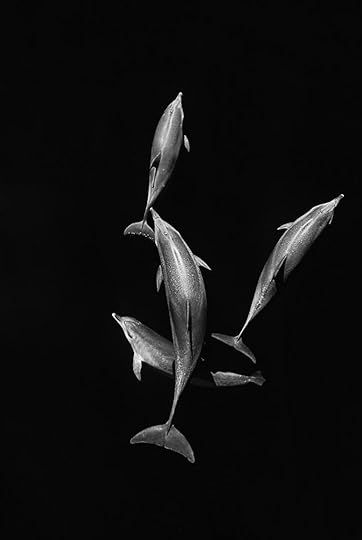
British photographer Christopher Swann captures stunning shots of cetaceans like whales and dolphins both above and beneath the surface of the ocean. With over 25 years of experience diving and running whale- and dolphin-watching holidays around the world, the photographer has become finely attuned to the behaviors of these majestic creatures, enabling him to venture close to them for intimate and eye-opening portraits.
Click here for full article with more great photos.

August 7, 2015
Dolphins are not healers
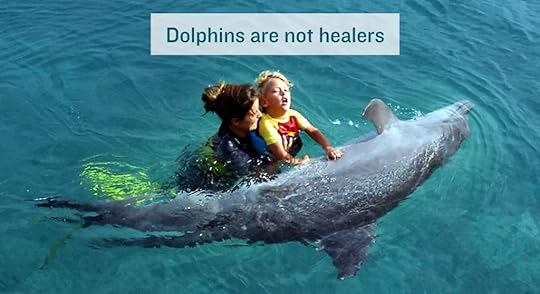 Imagine this. Jay, an eight-year-old autistic boy, whose behaviour has always been agitated and uncooperative, is smiling and splashing in the pool. A pair of bottlenose dolphins float next to him, supporting him in the water. Jay’s parents stand poolside as a staff member in the water engages him in visual games with colourful shapes. She asks him some questions, and Jay, captivated by his surroundings, begins to respond. He names the shapes, correctly, speaking his first words in months. With all this attention Jay is in high spirits; he appears more aware and alert than ever before. A quick, non-invasive EEG scan of his brain activity shows that it is indeed different from before the session.
Imagine this. Jay, an eight-year-old autistic boy, whose behaviour has always been agitated and uncooperative, is smiling and splashing in the pool. A pair of bottlenose dolphins float next to him, supporting him in the water. Jay’s parents stand poolside as a staff member in the water engages him in visual games with colourful shapes. She asks him some questions, and Jay, captivated by his surroundings, begins to respond. He names the shapes, correctly, speaking his first words in months. With all this attention Jay is in high spirits; he appears more aware and alert than ever before. A quick, non-invasive EEG scan of his brain activity shows that it is indeed different from before the session.
Jay’s parents, who had given up hope, are elated to have finally found a treatment that works for their son. They sign up for more sessions and cannot wait to get home and tell their friends about the experience. They are not surprised to find that dolphins have succeeded where mainstream physicians have not. Everyone believes that dolphins are special — altruistic, extra gentle with children, good-natured. And any concerns the parents might have had about the welfare of the dolphins have been allayed by assurances from the trainers that they are happy and accustomed to the role they are playing. After all, as the parents can see for themselves, the dolphins are smiling.
‘Jay’ is a composite character drawn from the dozens of testimonials that appear on dolphin-assisted therapy (DAT) websites, but stories like his, stories about the extraordinary powers of dolphins, have been told since ancient times. Much of our attraction to these creatures derives from their appealing combination of intelligence and communicativeness, and the mystery associated with the fact that they inhabit a hidden underwater environment. Dolphins are the Other we’ve always wanted to commune with. And their ‘smile’, which is not a smile at all, but an anatomical illusion arising from the physical configuration of their jaws, has led to the illusion that dolphins are always jovial and contented, compounding mythological beliefs that they hold the key to the secret of happiness.
The mythic belief in dolphins as healers has been reiterated down the ages from the first written records of encounters with these animals. In Greco-Roman times, dolphins were closely linked with the gods. Delphinus was a favourite messenger of Poseidon, who repaid him for his loyalty by placing an image of a dolphin in the stars. The Greek poet Oppian of Silica declared around 200 CE that ‘Diviner than the Dolphin is nothing yet created.’ Aristotle was the first to recognise that dolphins are mammals. Indeed, the root of the word dolphin, delphus, means womb, and underscores the long-standing belief in an intimate (even chimeric) connection between dolphins and humans.
In ancient Rome and Mesopotamia, dolphins adorned frescoes, artwork, jewellery and coins, and in ancient Greece the killing of a dolphin was punishable by death. The Minoan palace of Knossos on Crete, dated to 1900—1300BC, contains one of the earliest and best-known ornamentations depicting dolphins in a fresco on the wall of the queen’s bathroom. In Greek mythology, Taras, son of Poseidon, was said to have been rescued from a shipwreck by a dolphin sent by his father, hence the image of the boy on a dolphin depicted on historical coinage.
The perception of dolphins as lifesavers is connected with beliefs that they possess magical powers that can be used for healing. The ancient Celts attributed special healing powers to dolphins, as did the Norse. Throughout time, people as far apart as Brazil and Fiji have traded in dolphin and whale body parts for medicinal and totemic purposes. Despite being saddled with these dubious supernatural attributes, there actually are several well-substantiated modern reports of dolphins coming to the aid of humans. In 2007, for example, a pod of bottlenose dolphins saved the surfer Todd Endris, who had been mauled by a great white shark off Monterey, by forming a protective ring around him, which allowed him to get to shore. But these instances are related to dolphins’ ability to generalise their natural anti-predator behaviours to another species, not to anything supernatural.
The intelligence and sophistication of dolphins is not just mythological, of course. Decades of scientific research has confirmed that they possess large and highly elaborate brains, prodigious cognitive capacities, demonstrable self-awareness, complex societies, even cultural traditions. In 2001 my colleague Diana Reiss and I provided the first definitive evidence for mirror self-recognition in two bottlenose dolphins at the New York Aquarium. Published in the Proceedings of the National Academy of Sciences, this study demonstrated, along with many others since, that dolphins have a level of self-awareness not unlike our own.
Yet in the face of this evidence for their very real brainpower, dolphins have been imbued with religious and supernatural qualities and remade into the ultimate New Age icon.
The person most responsible for fuelling modern, New Age notions of dolphins as morally superior spiritual healers is the late neuroscientist John C Lilly, who pioneered research with captive dolphins in the 1960s. Lilly’s early work on dolphin brains and behaviour, conducted in laboratories in the US Virgin Islands and in Miami, was groundbreaking, bringing to light important knowledge about the species’ large, complex brains and keen intelligence. Lilly also provided evidence for dolphin sophistication in the realm of communication, reporting that dolphins could mimic the rhythm of human speech patterns.
In a paper published in Science in 1961, Lilly reported in detail on the range of ‘vocal’ exchanges between two dolphins in adjacent tanks, each equipped with a transmitter and receiver — Lilly’s dolphin ‘telephone’ — and noted how their ‘conversation’ followed polite rules; for example, when one ‘spoke’, the other was quiet. Lilly drew up a dolphin lexicon showing that dolphins used a variety of communication methods, from blowing and whistling to clicking. Convinced that dolphins had a sophisticated language of their own, he suggested that the species might provide the key to unlocking humanity’s potential to commune with extraterrestrials. He became part of the initial SETI (Search for Extraterrestrial Intelligence) group of radio-astronomy pioneers, who were so impressed with his tales of dolphin intelligence that they voted to call themselves ‘The Order of the Dolphin’.
However, Lilly and his followers eventually began mixing their own quasi-spiritual beliefs with their scientific work. They also began engaging in scientifically and ethically questionable research, including giving captive dolphins doses of LSD. In one ethically dubious experiment dating from 1965, Lilly’s research assistant Margaret Howe spent 10 weeks living with a dolphin named Peter in a tank rigged up to contain just enough water for the dolphin to swim in and for Howe to wade in. Within weeks, it became clear that Peter was less interested in Howe as a room mate than as a conjugal mate, and to stave off his increasingly aggressive behaviour, Lilly encouraged Howe to relieve the dolphin’s erections.
Lilly’s claims about the superior nature of dolphin spiritual and moral qualities soared well beyond any legitimate data. ‘We can presume that they have ethics, morals and regard for one another much more highly developed than does the human species,’ he wrote in The Dyadic Cyclone (1976). On the back of this conviction, he attempted to set up a formal but overly expansive programme of interspecies communication and co-operation between humans and dolphins called the Cetacean Nation, which was, needless to say, never fully realised.
Despite (or perhaps because of) his controversial activities, Lilly became a counter-cultural guru and was very influential in promoting the use of dolphins in captive research. His informal studies of dolphins interacting with autistic children led him to make outrageous claims about the psychic powers of dolphins, which have since become the basis for many pseudoscientific claims made by DAT facilities.
Excerpt from an essay by Lori Marino
Read full essay: Aeon

August 5, 2015
6 pilot whales dead after beaching in Cape Breton; 10 others saved
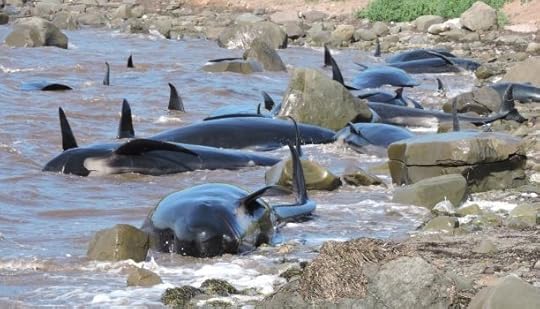 Sixteen pilot whales beached on a shore near Judique, Cape Breton, Canada, Tuesday morning, sparking a rescue effort involving about 20 people.
Sixteen pilot whales beached on a shore near Judique, Cape Breton, Canada, Tuesday morning, sparking a rescue effort involving about 20 people.
Andrew Reid with the Marine Animal Response Society said 10 of the whales were pushed into deeper water and survived. Six others died.
Local resident Maggie MacIntyre said people gathered at the beach early in the morning for the rescue effort.
“There were between one and four people surrounding each whale,” she said.
“For as many whales as we could, people were just trying to keep them upright and trying to nudge them out to deeper water.”
MacIntyre said the whales ranged in size, including a baby that was less than a metre long and adults that were up to 3½ metres in length.
She said they were told that if the pilot whales’ blowhole isn’t kept upright, the whales would die.
“We were just trying to do what we could until the tide got high — just keeping them upright. And as the tide came in there started to be a bit of a lift, we’d try to push them out into the deeper water.”
MacIntyre said the group of rescuers grew from a dozen to about 20 people by the time she left.
“[The whales] were heavy. Trying to keep them upright took multiple people putting all of their weight into it.”
One of those helping in the rescue effort was CBC host, Carol Off who happened to be visiting the area. She told CBC’s As It Happens it was an incredible scene. She said residents came from everywhere to help, and watched one woman wade in wearing her pajamas.
Full story: CBC news

July 30, 2015
Baby Dolphin Never Even Got To See The Ocean
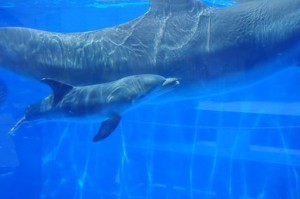
This week, Marineland Dolphin Adventure announced the loss of a baby born to the dolphin Casique on its Facebook page.
Marineland Dolphin Adventure is deeply saddened to announce the loss of our female dolphin calf, born July 12 to one of our resident dolphins, Casique. Over the past several days, our veterinary and animal care teams have provided constant care for Casique and her calf, but became concerned when the calf developed a respiratory condition and Casique’s maternal behavior declined. This is an extremely difficult loss for the Marineland family, and we welcome your positive thoughts and support.
The Florida park was the home of the world’s oldest dolphin in captivity, who spent 61 years in a tank before passing away last year.
Living this long in captivity is rare, though. According to the Oceanic Preservation Society (OPS), dolphin and orca life expectancies are cut drastically in captivity: While dolphins will live for up to 40 and 50 years in the wild, in parks their survival rates are staggeringly low. At SeaWorld San Antonio, for example, the average lifespan of a captive-bred dolphin is four years.
Short or long, life in a tank for a wild animal is really no life at all.
Source: The Dodo

July 26, 2015
Protesters film slaughter of hundreds of whales in the Faroe Islands
Faroese villagers have slaughtered about 250 pilot whales in the past 24 hours according to Sea Shepherd activists monitoring the traditional summer hunts in the north Atlantic islands.
The whale pods, which migrate past the islands in July and August, were herded by flotillas of small boats on to two beaches where villagers waded into the water to kill them with lances.
Seven protesters, mainly from European countries, have been arrested this week for allegedly interfering with the the traditional community hunts, known as “grindadráp”.
Full story: The Guardian

July 24, 2015
Rangers rescue baby harbor porpoise on Oregon Coast
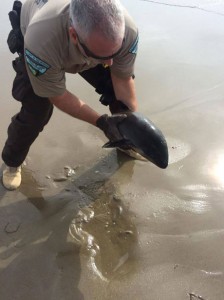 Rangers helped a baby harbor porpoise found beached out on the North Spit in Coos Bay last week in the US.
Rangers helped a baby harbor porpoise found beached out on the North Spit in Coos Bay last week in the US.
Bureau of Land Management Rangers Shane Presley and Ted Gage waded into the water to help it back into the surf and hopefully back to its family.
The rangers consulted with NOAA before releasing the animal back into the surf.
Source: Kval.com

July 23, 2015
Two dolphin species band together to form unprecedented alliance
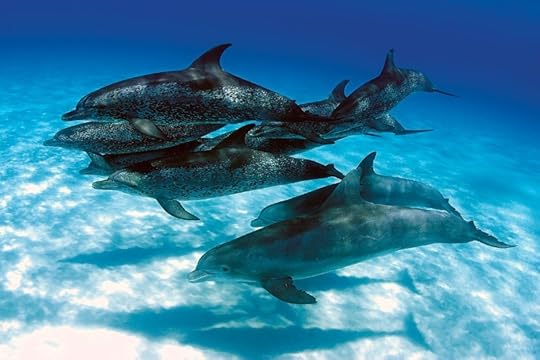 It’s a social network like no other. The dolphins of the Bahamas forage and play together and forge alliances – even though they belong to two distinct species. They’re not the only example of mixed-species dolphin groups, but this level of interaction is unprecedented.
It’s a social network like no other. The dolphins of the Bahamas forage and play together and forge alliances – even though they belong to two distinct species. They’re not the only example of mixed-species dolphin groups, but this level of interaction is unprecedented.
“These interactions likely evolved to allow the species to share space and resources and maintain a stable community,” says Cindy Elliser at Pacific Mammal Research in Anacortes, Washington. She previously worked with Denise Herzing at the Wild Dolphin Project, which has been studying social ties between Atlantic bottlenose (Tursiops truncatus) and spotted (Stenella frontalis) dolphins in the Bahamas for 30 years.
The observations suggest that the two species spend about 15 per cent of their time together, says Elliser. More than half of those encounters involve “friendly” behaviours. “They play and forage together. They even babysit,” she says. On at least two occasions adult female spotted dolphins appeared to be caring for baby bottlenose dolphins for short periods. Researchers have also seen three spotted and two bottlenose dolphins, all pregnant, swimming together.
Elliser says the reasons for these specific behaviours remain a mystery, but it is not simply down to a few individuals with a confused sense of their own identity. “I think that the friendly behaviours are an important part of maintaining relationships.”
“They play, forage and even babysit together. It’s an important part of maintaining relationships”
The males, too, form alliances to fight common foes. In one encounter, for example, two males from each species banded together to confront and chase off an intruder – another male bottlenose dolphin.
We knew that male dolphins routinely form alliances with others of their species. For example, male bottlenoses from Shark Bay, Australia, form large “third-order” groups made up of gangs that are, in turn, made up of two or more duos or trios. But the cross-species dolphin alliances in the Bahamas are unique so far, says Elliser.
Humans are the only other animal known to form such complicated nested alliances, says Richard Connor at the University of Massachusetts, Dartmouth – although ours go beyond three orders. We cooperate at the family, community, national and international level, for instance. Early human species probably interacted with each other, too (see “Neanderthals as neighbours“).
It is probably no coincidence that dolphins and humans share this sophisticated cognitive ability to cooperate, Connor says, since these are the two animals with the largest brain for their body size. He also says there may be real social complexity in the Bahamas encounters, particularly given that so many of them seem to be friendly. This only adds to the evidence that dolphin social ties are particularly sophisticated.
Not all interactions between the two species are friendly, though. Bottlenose males are about twice as long as spotted males and sometimes exploit this to force their way into groups of spotted dolphins and mate with females. Elliser and Herzing found that male spotted dolphins can fend them off, but only by cooperating in very large groups (Marine Mammal Science, doi.org/583).
This cross-species mating may be a way for juvenile male bottlenoses to learn to compete with large males of their own species, Elliser suggests. It may also explain why a larger proportion of spotted rather than bottlenose dolphins routinely engage in the mixed species encounters: the smaller spotted dolphins have to work harder to keep the interactions even.
It’s still too early to say we fully understand the motives behind encounters between dolphin species, but we might have more chances to study them as climate change forces them to share the same waters.
“These types of interactions in social animals may become more common,” says Elliser.
Full story: New Scientist

July 22, 2015
Dog saves baby dolphin
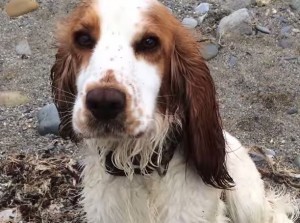 A dog named Leia made a remarkable find while wandering Criccieth Beach in Wales with her owner. She discovered a baby dolphin beached on the shore, struggling to make its way back into the ocean. Upon finding the creature, Leia alerted her owner and he guided the dolphin back into the water. The owner waited until the dolphin, now named Buddy, was safely in the water before leaving to find reception and call the Coastguard.
A dog named Leia made a remarkable find while wandering Criccieth Beach in Wales with her owner. She discovered a baby dolphin beached on the shore, struggling to make its way back into the ocean. Upon finding the creature, Leia alerted her owner and he guided the dolphin back into the water. The owner waited until the dolphin, now named Buddy, was safely in the water before leaving to find reception and call the Coastguard.
Source: Good

July 20, 2015
First observed wild birth and acoustic record of a possible infanticide attempt on a common bottlenose dolphin
Introduction to paper, see link for full details:
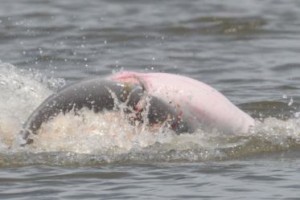 We observed the birth of a common bottlenose dolphin (Tursiops truncatus) followed immediately by a possible infanticide attempt in the estuary near Savannah, Georgia. Our report is unique in several ways: first, we witnessed the birth of the calf; second, we observed infanticidal behavior almost immediately afterward; and third, we obtained acoustic recordings concurrent with the possible infanticidal behavior.
We observed the birth of a common bottlenose dolphin (Tursiops truncatus) followed immediately by a possible infanticide attempt in the estuary near Savannah, Georgia. Our report is unique in several ways: first, we witnessed the birth of the calf; second, we observed infanticidal behavior almost immediately afterward; and third, we obtained acoustic recordings concurrent with the possible infanticidal behavior.
Our observations provide insight into aggressive, possible infanticidal, behavior in bottlenose dolphins.
Full paper: Marine Mammal Science





